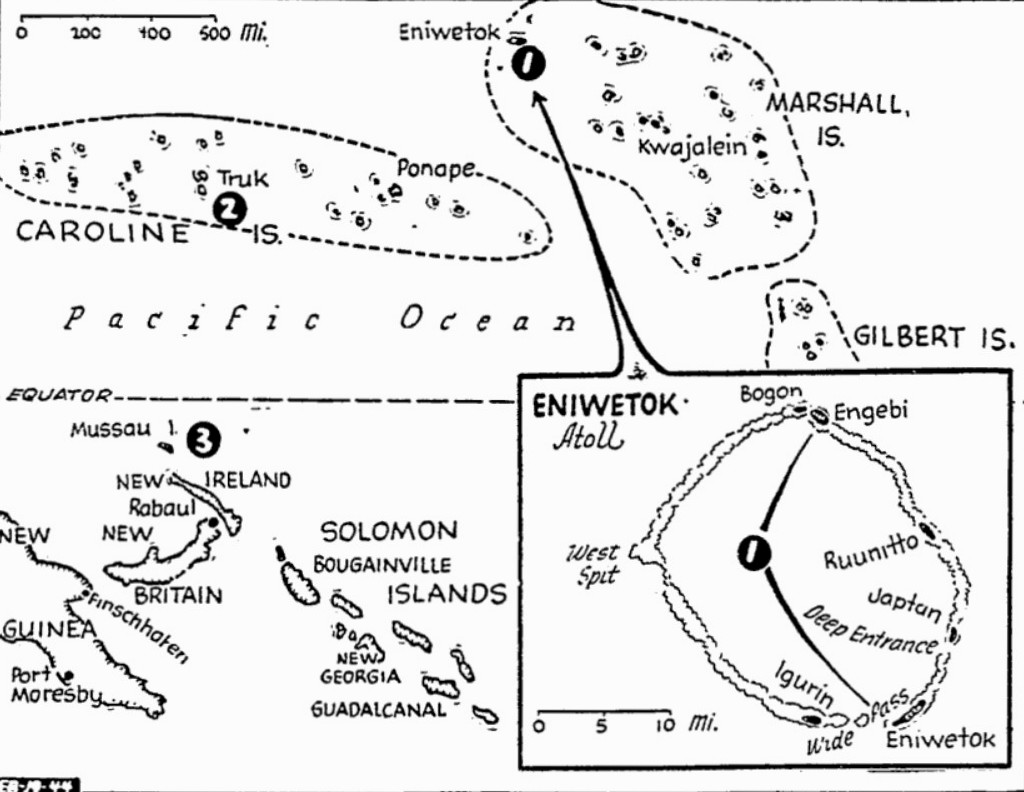The Pittsburgh Press (February 19, 1944)
NEW MARSHALLS ATOLL INVADED
Yank forces pour ashore on Eniwetok
U.S. victory on island group 750 miles from Truk in sight
By William F. Tyree, United Press staff writer
Second strike in the Marshalls found U.S. forces ashore on Eniwetok Atoll (1), 750 miles northeast of Truk (2), which was pounded this week by U.S. bombers. To the south, Allied planes destroyed a Jap convoy of 15 ships near Mussau Island (3).
Pearl Harbor, Hawaii –
Meager official reports indicated today that powerful U.S. Marine and Army invasion forces were rapidly extending their initial beachheads on Eniwetok Atoll, 750 miles northeast of bomb-battered Truk, with complete conquest perhaps already in sight.
While 16-inch-gun U.S. battleships joined cruisers, destroyers and planes in a pulverizing bombardment to cover the advances on Eniwetok, other elements of the Pacific Fleet were apparently retiring from the Carolines after subjecting the bastion of Truk to a smashing carrier-based air assault.
Radio Tokyo last night again told the Japanese people of “fierce fighting” at Truk and warned that the U.S. attack was part of an offensive pattern whose ultimate aim was an assault on Tokyo. The broadcast added no fresh details to yesterday’s Jap communiqué, which said Jap Army and Navy forces had intercepted U.S. units.
A Jap Dōmei dispatch from a Central Pacific base said U.S. warships had shelled and carrier-based planes bombed Taroa Island in Maloelap Atoll, east of Kwajalein, Wednesday and Thursday, causing “slight damage.” Fifteen planes attacked Wednesday and 16 Thursday, the dispatch said.
20,000 land
The 22nd Marine Division and elements of the Army 106th Infantry Division (probably a total of at least 20,000 men) pushed ashore on Eniwetok under a drumfire air-sea bombardment Thursday and successfully established beachheads, Adm. Chester W. Nimitz, commander of the Pacific Fleet, announced in a communiqué yesterday.
Though no further bulletins have been issued by Adm. Nimitz’s headquarters, the fact that the invasion forces were able to consolidate their beachheads – the toughest phase of any amphibious assault – tended to justify optimism that Eniwetok might be occupied as quickly as was Kwajalein, 355 miles to the southeast, which fell after an eight-day battle.
To use Kwajalein pattern
The communiqué gave no hint as to the extent of the opposition encountered, but it seemed probable that the terrific preliminary and accompanying bombardment had razed most of the enemy’s long-prepared pillboxes and artillery emplacements.
RAdm. Richmond Kelly Turner, invasion commander, was expected to follow the Kwajalein pattern of sweeping rapidly across the invaded islands to smash all organized resistance with the aid of tanks, artillery and flamethrowers, then mop up the scattered remnants.
Though Adm. Nimitz did not identify the site of the initial landings in the 21-by-17-mile circular atoll at the northwestern corner of the Marshalls, the main objectives were believed to be Engebi Island (2,000 yards long and 1,500 yards wide at the northern end) and Eniwetok (a narrow heavily-wooded island about 4,000 yards long at the southern end).
Contains good anchorage
Possession of Eniwetok Atoll would give the United States one of the finest fleet anchorages in the Pacific and an air base on Engebi Island with a runway nearly 5,000 feet long which could be used in conjunction with Bougainville, to the southwest, for shuttle raids on Truk.
The lightning assault on Eniwetok, coming only 10 days after the final conquest of Kwajalein, carried U.S. ground forces 2,500 miles west of Pearl Harbor on the invasion route to Tokyo and represented an advance of nearly 1,000 miles in the past three months dating from the capture of the Gilberts.
The invasion of Eniwetok also further increased the isolation of Wake Island, 600 miles to the northeast.
Turner’s staff
Under Adm. Turner’s overall command for the invasion were RAdm. H. W. Hill, commander of amphibious forces; Marine Brig. Gen. Thomas E. Watson of Washington, commander of ground forces; Col. John T. Walker, 50-year-old Texan commander of the Marines, and Col. Russell G. Ayers, commander of Army troops.
Powerful naval task forces which sent carrier-based planes against Truk Wednesday were still maintaining radio silence and details of the destruction they wrought awaited their return to friendly waters.
Silent on Truk
Adm. Nimitz and his commanders remained silent on Tokyo’s implications that the forces, which included one of the largest concentration of aircraft carriers of the war, had tried to land invasion forces. However, it was generally assumed that Tokyo, for propaganda purposes, was attempting to twist an air assault into an unsuccessful landing attempt.
Though there had been no confirmation of Jap counterblows, it appeared certain the enemy would do all in his power to catch the task forces, which probably included battleships as well as carriers, cruisers and destroyers.
